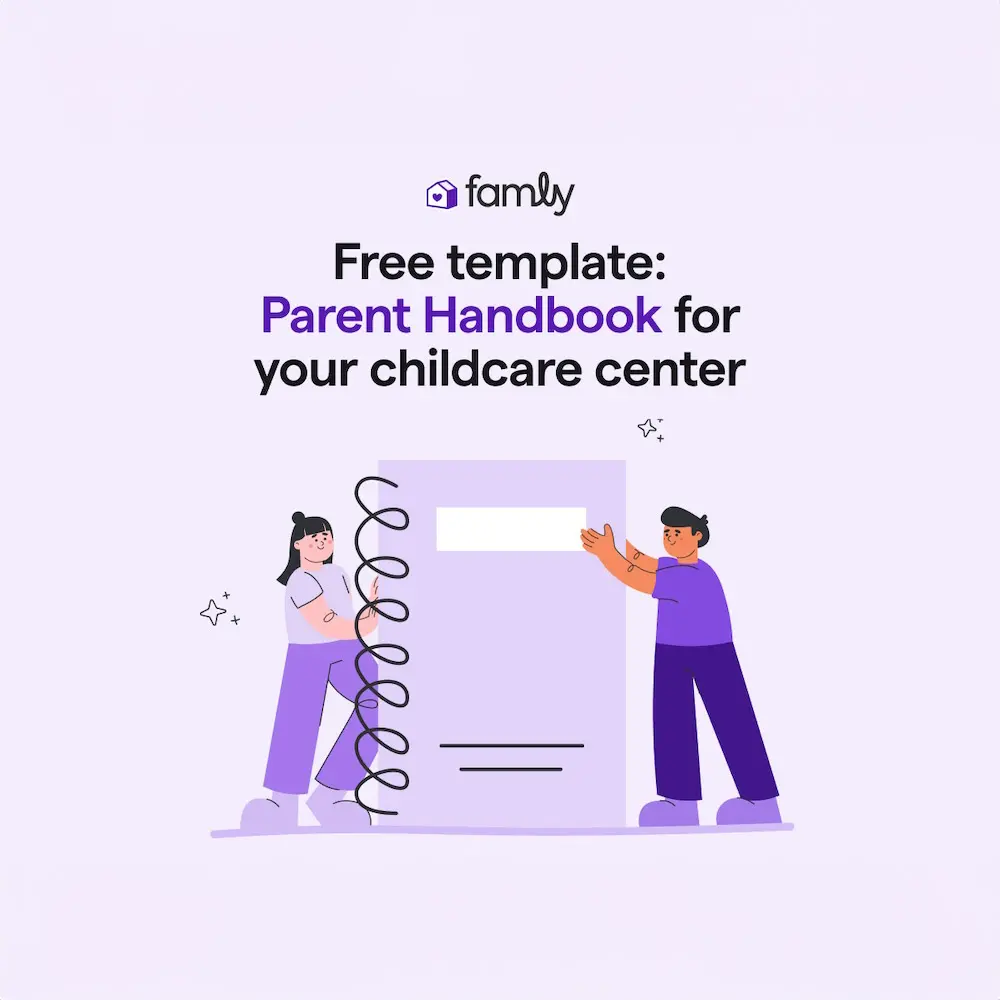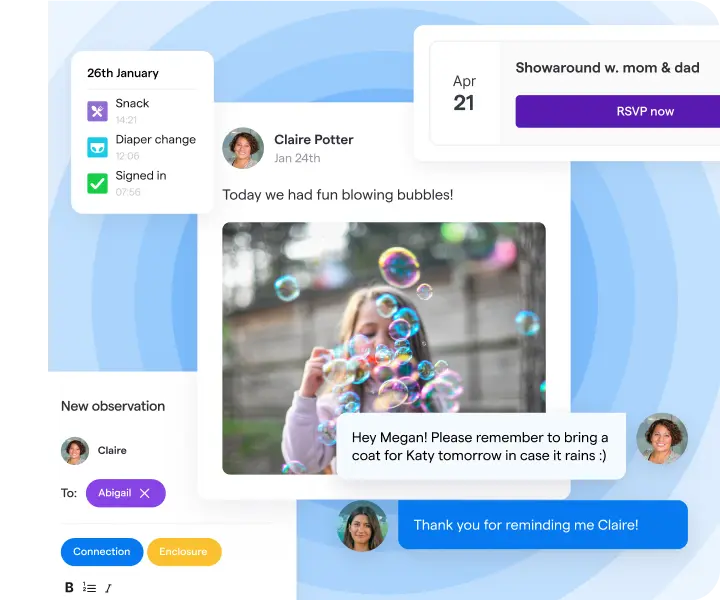settings
children
With Famly since

*Please note: family handbook and parent handbook are used interchangeably.
A Famly Handbook or Parent Handbook for your preschool, daycare or childcare center is key in bridging the gap between home and early childhood education (ECE) settings. It acts not just as a guide to the policies and procedures of the center, but also as a foundation for building an open and trusting relationship between parents and families and ECE staff.
There are two main purposes of your parent handbook:
- Set families and parents’ expectations.
By clearly explaining expectations, daily routines, and operational guidelines, your preschool’s parent handbook ensures families are informed about the quality of care and the environment their children will be in. This helps establish clear standards and expectations for everyone involved (and clear expectations helps minimize possible disagreements at a later time).
- Give back more time to you and your staff.
The clearer the parent handbook is written, the less phone calls, emails and messages your staff will get from parents asking questions about pick-up, drop-off, tuition, payment, accidents and injuries, and so on. Even though you give the parent handbook at the beginning of the year, it should be something that parents refer to throughout the year whenever they have any questions.

What sections to include in a childcare parent handbook
Whether you are writing a new parent handbook for your center, or improving your current one, this article and free downloadable template will give you all you need to have a clear and informative handbook.
Of course, every handbook will vary depending on the childcare center, the programs provided, the curriculum and location. Still, there is crucial information that all handbooks should include.
Also, it can be overwhelming to give families a 25 page document, but with a Table of Contents, and clear sections and subsections (which this template will provide), it will be much easier to understand.
1. Introduction & welcome:
This should include a welcome note to the families - can be as long or as short as you would like. This section should also explain the purpose of the childcare, preschool or daycare parent handbook.
This is also a good place to put your center's contact information, so it is easily accessible for families at any time throughout the year.
2. Philosophy & administrative information:
Within this section you should talk about your center’s philosophy and your mission statement.
This should also highlight your approach to early childhood education, and how your curriculum supports your philosophy and mission. For example, do you have a Montessori program? Or a play-based learning approach? Or a focus on STEM learning? Explain the goals and objectives of your curriculum, and if necessary, specify the aims of each cohort or age group.
The big ideas

This information will help parents understand how their children will be spending their days and how teachers will approach the children’s learning and development. Simply, you want to make sure parents are excited about the ECE program they decided to enroll their child in.
Remember: It is important to use language that the families will understand. Even though you and your staff may be familiar with ECE- or program-specific terminology, you can’t assume families know too.

3. Program details & operating information:
This is where you explain all the programs you offer at your center, such as age ranges, half-day or full-day, whether you offer a summer program, etc.
You should also go into some of the specifics of each program, like their operating hours, and a sample daily schedule. Parents like to imagine how their child will be spending their days and the various types of learning activities they will do, and a sample daily schedule is a great way to do that.
In this section of the family handbook, you should also include a calendar for the year, so parents can know well in advance what holidays your center is closed for, and when spring break, winter break and teacher days are planned for. Also, make sure to highlight if there are any holidays that you are not completely closed, but will have limited operating hours.
If you already know which week parent-teacher conferences will be held, or if you have any other annual events that you know the date for, you should include those as well so families can block their calendars, and you are likely to have a higher participation and attendance.
4. Sign-in, drop-off, pick-up & attendance:
The parent handbook should include your center’s procedures for sign-in, sign-out, pick-up and drop-off. Specifically, how do you keep track of the persons authorized to pick up each child? Do you use a digital sign-in?
Pick-up and drop-off can be chaotic times, so use this section of the parent handbook to help parents feel prepared and know what to expect. This will help these transition times go a bit smoother for the parents, and the staff as well.
Don’t forget to include your policies around early & late drop-off or early & late pick-up. Also, what is your sick policy? When and how should the families inform the teacher that their child is not coming due to an illness? Are parents still charged for days missed due to being sick?
With so much information and rules, this can be a good time to explain why your attendance policies are put in place, specifically how important it is to have all classrooms be in ratio.

5. Enrollment, waitlists & withdrawals:
Even though the parent handbook is typically shared with families that are already enrolled in your center, it is important to have this section so they can reference it if they want to re-enroll for the following year, or if they have another child they want to enroll.
(It also is a great way for current parents who talk positively about your program to be able to easily share the application and enrollment process to interested parents).
As mentioned, you should include the registration and enrollment process for both new students and returning students, and also if you have any special sibling policy.
Don’t forget to also include your withdrawals and dismissal policy, such as if you require a 30-day or 14-day notice or how deposits are handled once a child withdrawals.
Parents also appreciate a clear checklist of all the forms they need to submit for enrollment. Your staff will appreciate it too because then they don’t have parents constantly calling and asking!
6. Billing, payment & finances
This is one of the most important sections for both parents and your center. It will help ensure you get paid on time because families will know due dates, accepted payment types, etc. It is in your best interest to make this section as clear and straightforward as possible.
This is where you go into the details on tuition and fees for all the programs you offer - full-day, half-day, infants, toddlers, ad-hoc sessions, summer program, etc.
Then, explain your payment structure, payment due dates and accepted forms of payment. Do you handle all billing online? Is it possible to sign up for automatic payments? Do you accept checks? Will you notify the parents if the credit card you have on file expires, or do they need to notify you?
What is your holiday payment policy? What is your sick policy? Will a family be reimbursed for the day(s) their child is not at childcare due to an illness? (This should also be included in the attendance section, as mentioned above. It never hurts to repeat crucial information.)
You should also clearly explain your late payment policy, so there are no disagreements or misunderstandings if that should occur.
7. Parental involvement & communication:
It is important to communicate consistently and build a partnership between families and ECE staff. While there are instances where you have to directly communicate with parents, this section is to explain how you engage the parents in the community, and in the day to day of their child’s development and learning journey.
In this section, you should include topics like:
- Do you send out a newsletter? How often?
- Where can families find daily updates or information about upcoming events?
- Do you have a social media account?
- Do you have a childcare app or software for communication?
- How can parents get more involved in the community?
- What’s the best way to communicate in non-emergency situations?
- You should also provide information about parent-teacher conferences.

8. Health, privacy, security, safety & emergency policies
This is where you provide all necessary information regarding the children’s health and safety. Let parents know where they can see your certifications and licensing, and explain state and city requirements and how you meet them.
But, most importantly, clearly explain how you handle situations so that parents are on the same page and know exactly what to expect. This will minimize misunderstandings and disagreements in emotional situations, and it will also help parents feel comfortable leaving their child in your care.
Some health & safety situations and topics to address are:
- Child abuse & neglect
- Emergency medical care
- Treatment of illness & accidents
- Medication & treatment Authorization
- Immunizations, vaccines & health requirements
- Americans with Disabilities Act
- Employee immunization requirements
- Outdoor play policy
Some privacy, security & safety situations and topics to address are:
- Personal information policy & confidentiality
- Code of conduct & discipline policy
- Procedures for parental notification
- Information regarding visits, trips & excursions
- Personal items storage
- Building security
- Staff requirements
Some emergency situations and topics to address are:
- Shelter in place
- Stranger, active shooter & emergency action plan
- Emergency evacuation procedure
- Emergency closings & inclement weather policy
9. Nutrition, naps & diaper changes
Having certain schedules and routines are helpful for young children and their development. By clearly outlining meal times and nap times, parents can know the schedule their child will be following while at your center. This will let parents know whether they need to plan accordingly by adjusting the routine at home if needed.
This will also inform parents about the types of food, snacks and meals you provide and how you handle any allergies or other food-related health issues.
Make sure to explain your diaper changing stations and how you make sure they are clean and sanitized. You should also include whether you provide areas for breastfeeding mothers.
Many times childcare centers need parents to bring supplies for their children’s day, such as a change of clothes, diapers, specific snacks if they have special food requirements, etc. By clearly communicating the supplies you need to function smoothly, parents can organize and prepare ahead of time.

10. Other information
Do you celebrate holidays that represent a diverse range of cultures and traditions? Do you allow birthday celebrations in the classroom? Can families bring in treats for their birthday? Are there food requirements due to allergies or other health issues?
This is where you should clarify your policy around holidays and birthday celebrations, so all families are on the same page.
Do you have a specific clothing or dress code? This is a great place to remind parents to send their children to childcare in clothes that are flexible and appropriate to play in both indoors and outdoors.
13. Famly - our childcare management platform & app
If you use a childcare management platform at your center, the parent handbook is a great place to explain what it is, how the parents should use it, and the information they can access through it.
It is also a great place to explain how to download the app and set up an account, so all the parents can be onboarded and ready to go at the beginning of the school year.
14. Acknowledgement, signature & date
Last, but not least, a section for families to acknowledge and sign that they have read through the handbook and agree to follow and adhere to the guidelines, rules and expectations that you have outlined.
Leave language barriers behind
Bring your multilingual community closer with an in-app live translation tool with over 130 languages.
Learn how live translation works







%20(2).png)

